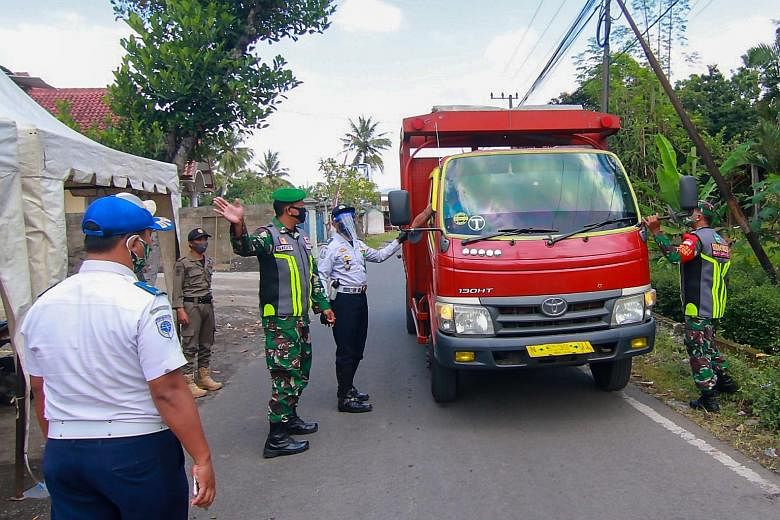Indonesia, whose Covid-19 testing rate is the lowest among countries with the highest infection numbers, is still far from the peak of the outbreak, experts said, arguing that the fraction of tests coming back positive is still high.
With 8,287 tests for every million people, Indonesia - the world's fourth most populous - is ranked the lowest among the countries with 100,000 cases or above, based on pandemic data site Worldometer. Bangladesh is the second worst with 9,563 tests for every million, and Mexico the third worst with 10,530.
Indonesia's positivity rate, which measures how many people who were tested turned out to have the virus, rose to between 11 per cent and 25 per cent last month, from between 7.7 per cent and 21 per cent in July .
Dr Laura Navila Yamani, an epidemiologist with Airlangga University, said a measure above 5 per cent means the virus is still spreading fast and that the number of infections could rise.
"Indonesia's curve may reach its peak and start to flatten only after we boost testing and the positivity rate falls below 5 per cent and remains there consistently in all regions across the country," Dr Laura told The Straits Times yesterday.
She said Indonesia's battle against the virus "should be supported by mass tests, coupled with people who comply with health protocols".
University of Indonesia epidemiologist Pandu Riono also doubted Indonesia could see its epidemic curve starting to flatten next month, saying it would be next year.
The experts' remarks were made after President Joko Widodo told a group of foreign media on Tuesday the outbreak would reach its peak this month before flattening next month, adding that the recent surge was due to increased testing.
Indonesia has ramped up its testing capacity, but it is still below the World Health Organisation's (WHO) standard, which is one test for every 1,000 people per week, Professor Wiku Adisasmito, a spokesman for the national Covid-19 task force, said yesterday. "For now the biggest challenge is carrying out testing massively," he said.
With a population of 267 million, Indonesia should raise testing capacity to 267,000 persons per week. Currently it has reached only 95,000 per week at the highest point, Prof Wiku noted.
President Joko said Indonesia's still-lagging testing rate is due to manpower constraints, adding that it is trying to train more people.
Dr Pandu suggested replacing the low-capacity testing equipment with higher-capacity, fully automated ones which require fewer operators.
Dr Laura also said Indonesia has not done enough of contact tracing, citing WHO's recommendation of doing tests on 30 possible close contacts for every one person who tested positive. Indonesia's average is fewer than five close contacts, she added.
Indonesia recorded 180,646 confirmed cases, the second highest in South-east Asia after the Philippines, and 7,616 deaths, the highest in the region, as of yesterday.
Meanwhile, an Indonesian senior minister, who is a close aide to President Joko Widodo has disputed the convention used by pandemic data site Worldometer which compares figures to population in its measurement of coronavirus testing, arguing that it is biased against countries with a vast geographical expanse such as Indonesia.
Indonesia is the world's largest archipelago with countless remote locations across its 34 provinces and more than 17,000 islands. With a population of 267 million, it is also the world' fourth most populous nation.
The Worldometer's metric for the number of conducted tests relative to its population is therefore inaccurate for countries such as Indonesia and Japan, Coordinating Maritime Affairs and Investment Minister Luhut Pandjaitan.
He stressed that Japan's test rate relative to its population - 11,795 per million - is around the same level as Indonesia's.
"We do very aggressive testing at least in six provinces with the highest coronavirus cases. We obviously do not need to be as aggressive, for example, in Bangka Belitung province," Mr Luhut told The Straits Times Thursday morning (Sept 3).
The 1.5 million population Bangka Belitung province has recorded a total 235 positive Covid-19 cases and two fatalities.
The six Indonesian provinces with the highest number of cases - Jakarta, East Java, Central Java, South Sulawesi, West Java and South Kalimantan - account for 68 per cent of the total infections in the country.
In a Wednesday virtual briefing, Professor Wiku Adisasmito, a spokesman for the national Covid-19 task force, said Indonesia has many islands where the traffic of people travelling in and out has been either very minimal or none at all.
A lot of these islands have not recorded any confirmed cases of coronavirus, Prof Wiku added.
There are 26 cities and regencies that have not seen any coronavirus cases and another 42 that have seen zero increase of new cases in the past week, according to the government data.
Nias Islands in North Sumatra province, Konawe islands in Southeast Sulawesi province, Aru Islands in Maluku province are among the regions that have not seen any Covid-19 confirmed cases.

